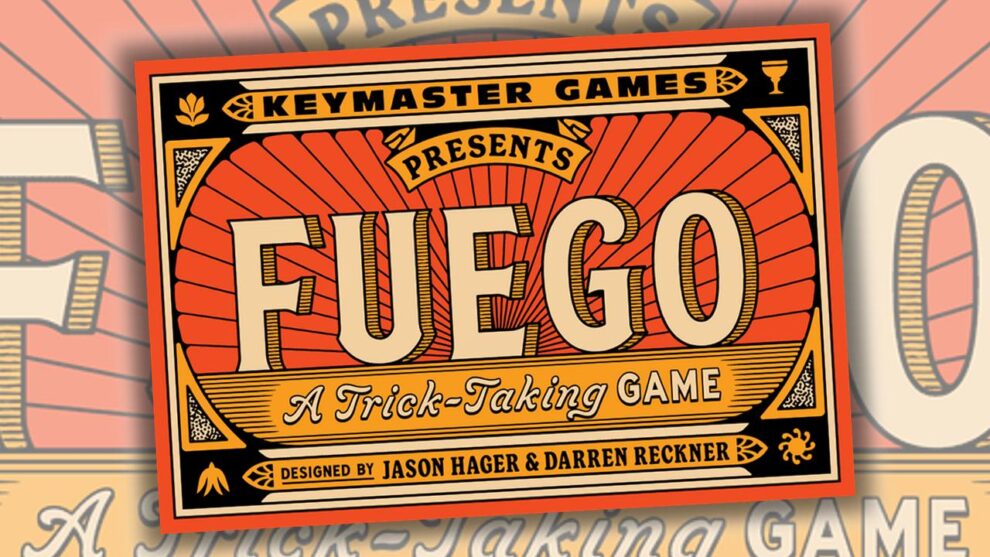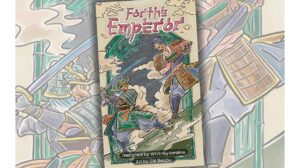Disclosure: Meeple Mountain received a free copy of this product in exchange for an honest, unbiased review. This review is not intended to be an endorsement.
I have had several enjoyable gaming experiences with the lineup from Keymaster Games. This includes a number of exceptionally well-produced games: PARKS, PARKS: Nightfall, Parks: Roll & Hike, Caper: Europe, and Harvest.
When the Keymaster team reached out to gauge my interest in a review copy of their upcoming trick-taking game Fuego I immediately said yes. I’ve never had a bad time with a Keymaster game, I always need shorter games to balance my plays with the heavy Euros I get to the table. And since nearly every publisher I work with has at least one trick-taking, shedding and/or ladder card game on the docket, I was curious. What angle would Keymaster bring to the river of card games coming to market?
Fuego is an above-average time at the table. Across three review plays—one each at two, three, and four players—I really enjoyed the cardplay and team dynamics in our four-player game more than the other player counts.

Strike a Match
Fuego is a 2-4 player trick-taking game. It is played as a best-of-three setup—the player or team that wins two rounds wins the game. With two players, it’s a simple head-to-head affair; with four players, each person’s teammate sits across the table from their partner. At three players, Fuego becomes a 1v2 game—one person plays solo and plays two cards per trick, while the other duo plays as a normal team. (I’ll say it now: I didn’t enjoy Fuego as much at three players as I did at the other player counts.)
Each player is dealt a hand of cards, and in a two- or three-player game, the solo player(s) also deal themselves a tower of seven cards splayed on the table in a format known in-game as a “Torch.” The Torch is an interesting idea. The player(s) with a Torch can play from their secret hand of cards dealt during setup, or from the face-up cards currently available in the Torch. As cards from the bottom of the Torch are played, 1-2 new cards are revealed that add to a player’s options during each trick.
Tricks are played to the table. Instead of just having each player play a trick card in front of themselves, Fuego asks players to place their played cards along the “Fireline”, where four markers indicate the place where the four cards can be seen by all players. (This felt as extraneous as it sounds when I wrote it, because some players wondered why they couldn’t just play their card in front of them. “Because this looks fancier” was my response.)
Fuego is a “must follow” game, so whoever leads a suit in one of the game’s four suits (green, purple, orange, blue, with each featuring a symbol to ensure color-blind players can differentiate the cards) establishes a suit that must be played by successive players if they have a card of that suit in their hand. Card values range from 1-8, so beyond those 32 cards, there are five “Wildfire” cards in the deck, ranging from 1-5. When played, Wildfire cards become the color of the lead suit, unless they are played first, in which case Fuego allows the player to go full UNO and name a color suit of their choice. (There is no trump suit in Fuego.)
When a player can’t follow, they can play any card from hand. This is especially helpful because Fuego gets a lot of fuel from its Match mechanic. When a player plays a card that has a value (not suit, value) equal to the card to its left, they have to shout “MATCH!” then flip both matching value cards face down, removing them from consideration when determining the winner of a trick. They also get a Strike token (for, you know, striking a match), which can be used to mess with certain variables of a card in the Fireline.
The player who plays the highest card in the lead suit (of the cards still face-up in the Fireline) wins the trick. The winner looks at the number of flame icons on their played card, which ranges from 0-3 (with higher value cards featuring lower amounts of flame icons), then adds a flame icon for each Wildfire card played into the trick. Then, they steal a number of flame tokens from their left-most neighbor (this will always be an opponent, because Fuego is played in teams) equal to the flame icons mentioned above.
Rounds end when any single player runs out of flame tokens, or if all cards have been played.

Vanilla, Until It’s Not
Base-game Fuego isn’t bad. I like team games, so my four-player game was fun as we navigated each trick while not divulging specifics of our hands to our teammates, trying to win the most flame tokens.
But Fuego really opens up when players figure out how to lean into the Strike tokens. Tricks become much more interesting battles when players each have a Strike token, in part because these tokens are face-up and are known to all players. One token I had boosted the value of a card by two, so just having that token as a threat made the opposing team consider how to play cards.
I also love that a player can only ever have one Strike token at a time, so they can’t lurk in the shadows hoping to unleash a barrage of tokens all at once. Players in my four-player game (a mix of seasoned trick-taking vets) quickly learned that the best way to get rid of a Strike token you don’t want is to play it into a trick that generates a match, so that you can potentially help your team and draw a new Strike token to be ready for the next trick.
Fuego comes with a small deck of “Caliente” cards, which are an optional addition to the core game that help swing each round in a new direction with situational rules that can stick for a single round or the entire game. My advice, if playing Fuego with seasoned gamers, even during your first game, use the Caliente cards. Then, like recent trick-takers such as Rebel Princess do with rules changes by round, use a different Caliente card for each round.

In the parlance of food seasoning, the Caliente cards in Fuego are more mild, maybe medium, and not truly hot. One of the cards, “Char”, dictates that if a team ever has nine or more flame tokens (there are 12 flame tokens available in total per round), they immediately lose the round instead of likely winning the round. So, it was fun to figure out a way to be good, but not great, in trying to win flame tokens. Cool, but certainly not earth shattering.
However, combining these variable round rules with the Strike tokens, the Match mechanic, and gaming ways to win the most tokens made Fuego a fun time. It was never “wow”, but like other Keymaster experiences, I enjoyed how solid Fuego was with the range of core and casual gamers who joined me. My family thought it was OK. My eight-year-old son, who did the two-player game with me, actually won our game, and he didn’t require any help in figuring out how to play or how to use the Torch mechanic during each round. (We did not use the Caliente cards in that play.)
The six unique individuals who joined me for my plays all said the same things—fun, incredible production, would happily play it, likely would not buy it. (To be fair, my son spends his allowance on video games.) From the bold-looking cover art, to the fantastic rulebook, to the player aid card, to the drawings on the cards, to the way the box insert pushes out to reveal the game…Keymaster just has an incredible “Spidey Sense” for how a game should look and feel, and that continues with the production elements of Fuego.
And with a playtime that always wrapped in under 30 minutes, Fuego keeps things moving. Give this one a look!











